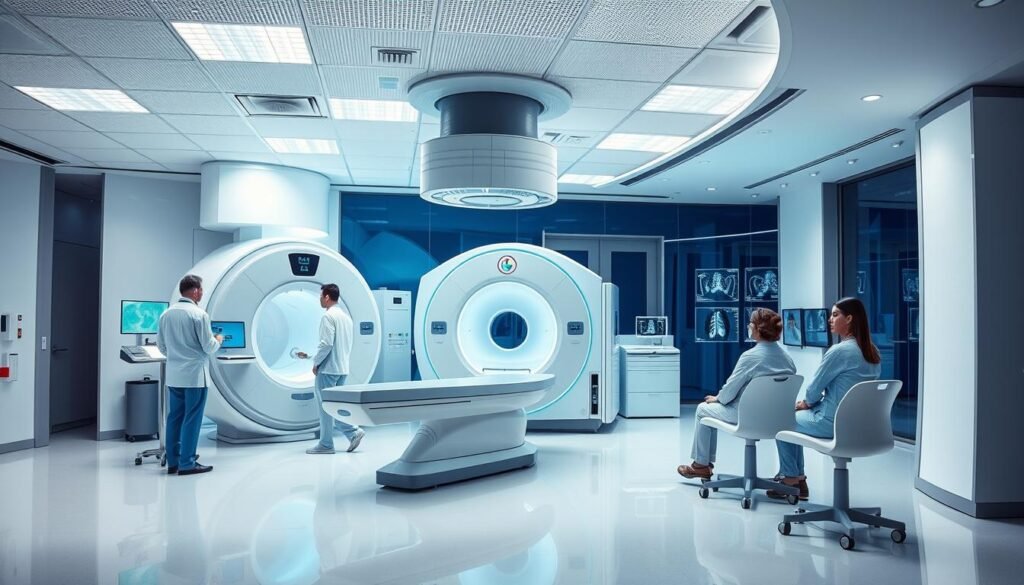Each year, more than 240,000 new cases of lung cancer are reported in the United States. This makes it a major health concern worldwide. In 2023, new breakthroughs in lung cancer treatment have emerged, changing the options for patients. These advancements are not only making treatments more effective. They also aim to better the quality of life for patients.
Remarkable progress has been made this year in targeted therapies and immunotherapy. These are leading to a more personalized approach to medicine. For example, the drug repotrectinib has shown promising results in clinical trials. It’s proving that treatments can be specifically designed for different types of lung cancer. This highlights the crucial role of continuous research and innovation in cancer care.
Looking into advanced treatment options and clinical trials is key for lung cancer management’s future. With a focus on new therapies and understanding patient needs, the latest treatments are set to change how people handle their cancer treatment. For more details on these advancements, visit this link.
Key Takeaways
- Over 240,000 new lung cancer cases reported in the US in 2023.
- Repotrectinib shows nearly 80% response rate in patients without prior ROS1 inhibitor treatment.
- Current advancements highlight the importance of personalized treatment strategies.
- New therapies improve survival rates for EGFR-mutant lung cancer.
- Early detection remains crucial for effective management of lung cancer symptoms.
Introduction to Lung Cancer Treatment
Lung cancer treatment consists of various methods. These include surgery, chemotherapy, and radiation therapy. Each method is key depending on the cancer type and stage. Most lung cancer cases are non-small cell lung cancer (NSCLC), about 85%. To choose the best treatment, knowing each cancer’s specifics is crucial.
Overview of Treatment Options
Surgery is very effective for early-stage lung cancer. It aims to remove the cancer and part of the lung. When cancer is advanced, chemotherapy uses powerful drugs. However, these drugs can have serious side effects. Radiation therapy targets cancer areas in the lungs directly.
There are new treatments like targeted therapies and immunotherapy. These treatments are more personalized. They are based on the genetic details of the cancer. For instance, drugs targeting EGFR mutations help patients with advanced NSCLC live longer without their disease getting worse.
Research programs now focus more on genetic tests to tailor treatment plans. This approach is known as personalized medicine. It takes into account each patient’s unique genetic profile and how they respond to treatments. By using these personalized strategies, lung cancer care is improving for patients everywhere.
Advancements in Immunotherapy
Immunotherapy is leading the way in lung cancer treatment advancements. This new method changes how we fight cancer cells. It boosts the immune system to better target and kill cancer. With recent FDA approvals, 2023 marks a big step forward in lung cancer treatments.
Understanding Immunotherapy’s Role
Immunotherapy is key in treating non-small cell lung cancer (NSCLC). This type makes up about 85% of lung cancer cases. It offers options that go beyond the usual chemo and targeted therapies.
- Pathological complete remission: The CheckMate-816 study showed great results for NSCLC patients using immunotherapy with chemo.
- Improved overall survival: The IMpower010 study found better survival rates in some NSCLC patients treated with atezolizumab after surgery.
- Enhanced efficacy: The CameL study revealed better response rates and survival times with immunotherapy plus chemo for certain NSCLC.
Recent FDA Approvals in 2023
The FDA’s 2023 approvals highlight immunotherapy’s increasing role against lung cancer. Pembrolizumab (Keytruda) and nivolumab (Opdivo) are now key for early NSCLC treatment. These advancements mean a big change in how we approach treatment, helping to improve surgery results and patient survival.
Research is looking into immunotherapy and chemotherapy combos through clinical trials. These trials are key to finding the best treatment plans, making immunotherapy essential in lung cancer care. The move toward personalized medicine with these treatments shows a team effort in improving care and outcomes for lung cancer patients.
| Immunotherapy Drug | FDA Approval | Key Findings |
|---|---|---|
| Pembrolizumab (Keytruda) | 2023 | Improves disease-free survival in NSCLC, specifically for patients with PD-L1 ≥ 1% |
| Nivolumab (Opdivo) | 2023 | Shows success in boosting overall survival rates in early-stage lung cancer |
| Atezolizumab | 2023 | Offers significant post-surgery benefits for Stage II–IIIA NSCLC patients |
Targeted Therapy Innovations
Targeted therapy is changing how we treat lung cancer. It’s especially helpful for patients with certain genetic changes. Instead of harming all cells like traditional chemotherapy, targeted drugs aim at specific parts of cancer cells. This approach leads to better results and gives hope for new treatments in the fight against lung cancer.
What is Targeted Therapy?
Targeted therapy uses drugs that attack specific parts of cancer cells caused by genetic changes. This makes the treatment more accurate. It stops cancer from growing and spreading without hurting healthy cells. Since 2023, this method has been crucial for treating a majority of lung cancers known as non-small cell lung cancer (NSCLC).
Key Breakthroughs in ALK and EGFR Inhibitors
In 2023, we’ve seen major progress with ALK inhibitors and EGFR inhibitors. Drugs like lorlatinib for ALK-positive NSCLC and osimertinib for EGFR mutations are showing great results in trials. These successes underline the value of genetic testing, leading to personalized treatments based on a patient’s specific cancer type.
The recent nod to use osimertinib as additional therapy is a step forward in targeted treatments. This move aims to lengthen the time patients live without cancer worsening if they have EGFR-positive tumors. Also, the approval of repotrectinib for ROS1-positive NSCLC is another important development in this field.
| Drug | Indication | Date of Approval |
|---|---|---|
| Lorlatinib | ALK-positive NSCLC | Approved |
| Osimertinib (Tagrisso) | EGFR mutations | October 30, 2023 |
| Repotrectinib (Augtyro) | ROS1-positive NSCLC | November 15, 2023 |
| Adagrasib (Krazati) | KRAS G12C mutations | December 1, 2022 |
New Lung Cancer Treatment 2023
In 2023, lung cancer care has changed a lot. There are new treatment innovations for patients. These advancements are making care better and improving outcomes.
Overview of the Latest Developments
New treatments got approved this year for non-small cell lung cancer (NSCLC). For instance, Keytruda (pembrolizumab) is now approved for certain post-surgery patients. It’s for those who had platinum-based chemo and have a high PD-L1 score, plus a history with proton pump inhibitors. The University of Texas MD Anderson Cancer Center has also highlighted how blood tests and risk factors can help identify patients at higher risk.
Impact on Treatment Protocols
Recently, Krazati (adagrasib) and Enhertu (fam-trastuzumab deruxtecan-nxki) have been approved. They target specific mutations in patients. This has introduced new treatment options. As a result, treatment guidelines are changing to focus more on the individual needs of patients.
Using Libtayo (cemiplimab-rwlc) with chemo has shown better results. Also, pairing drugs like Opdivo (nivolumab) with chemo seems promising for early-stage NSCLC. Clinical trials are ongoing to find more effective drug combinations. This evolving approach aims to give patients more personalized care. It’s changing how lung cancer is treated, leading to better outcomes.
Clinical Trials and Research Progress
Clinical trials are key in improving lung cancer treatments. They test new therapies to see if they’re safe and work well. These studies help make patient care better. Knowing how clinical trials work is important for future lung cancer treatments.
Importance of Clinical Trials
Clinical trials are crucial for making new cancer treatments. Researchers study new drugs and how they fight cancer. This leads to new treatment options. One example is the CROWN study. It showed that a new drug helped patients with a certain type of lung cancer stay cancer-free longer.
Notable Trials Impacting Treatment Options
Recent trials have changed how we treat lung cancer. One study, TRIDENT-1, looked at a new drug for a specific lung cancer. This drug got FDA approval in 2023.
- The LAURA study set a new care standard with osimertinib for EGFR+ NSCLC after certain treatments.
- The ALINA trial found that alectinib gives better results than old chemotherapy methods.
- At the ASCO 2024 meeting, the benefits of adagrasib for KRAS+ NSCLC were highlighted, thanks to the KRYSTAL-12 trial.
Research into at-home injections of amivantamab shows they might be better than IV infusions at clinics. These findings are thanks to detailed clinical trials. They aim to find better treatments for lung cancer.
To learn more about clinical trials, check out this resource. It offers updates on research looking to change lung cancer treatments.
Lung Cancer Screening Improvements
Lung cancer screening has gotten much better thanks to low-dose CT scans. These scans are really important for people at high risk. Studies show catching it early can make a huge difference in survival rates. The National Lung Screening Trial showed low-dose CT scans can significantly lower death rates among people 50 to 80 who’ve smoked a lot.
However, not enough people are getting screened for lung cancer. In 2023, only 16% of those who should get screened actually did. This tells us we need to do more to spread the word and make screenings easier to get. For instance, in California and Wyoming, the rates were extremely low, at just 0.7% and 1.0%. Meanwhile, Massachusetts did much better with an 11.9% rate, showing us that where you live plays a big role.
Screening methods for lung cancer have become more sophisticated. Now, tests on blood and spit can help find lung cancer earlier with greater accuracy. This can significantly improve the chances of beating the disease. Thanks to machine learning, we’re getting even better at spotting cancer, making this an exciting time in the battle against lung cancer.
| State | Lung Cancer Screening Rate |
|---|---|
| Massachusetts | 28.6% |
| Rhode Island | 28.6% |
| California | 0.7% |
| Wyoming | 1.0% |

Precision Medicine Approaches
Precision medicine is changing how we treat lung cancer. It customizes treatments based on each person’s genes. This method uses biomarkers to choose the best therapy. It aims to make treatments more effective and help patients do better.
As we learn more about lung cancer, knowing about biomarkers is key. They help us use the right therapy at the right time.
The Role of Biomarkers in Treatment
Biomarkers are very important in precision medicine. They help understand the cancer, like spotting changes in certain genes. Things like liquid biopsies can quickly tell us about the cancer. This means doctors can change treatment fast if needed, which is vital for severe lung cancer cases.
Case Studies and Success Stories
Many case studies show how targeted treatments have helped lung cancer patients. For example, patients with specific genetic changes did well with a new drug called osimertinib. The FLAURA trial showed it works well as a first treatment. Also, checking ctDNA can warn of cancer coming back early. These steps in precision medicine give much hope for better survival and life quality.
Treatment Side Effects and Management
Lung cancer treatments like chemotherapy, immunotherapy, and targeted therapies often cause side effects. These can seriously affect a patient’s life. Side effects include tiredness, nausea, hair loss, and appetite changes. It’s key to know about these to manage lung cancer well.
Immunotherapies, for example nivolumab and pembrolizumab, can trigger immune-related side effects. These might be skin rashes or stomach issues. Targeted therapies such as lorlatinib and alectinib also have side effects like feeling tired and swelling. It’s very important to keep a close eye on patients to deal with these issues quickly.
To improve patient care, doctors use supportive strategies. These include:
- Maintaining open communication about side effects.
- Utilizing medications to manage nausea and pain.
- Providing nutritional counseling to address appetite changes.
- Encouraging physical activity, when possible, to combat fatigue.
Talking with patients about how they feel about treatment and side effects is key. Focusing on lessening side effects makes patients more comfortable. It also helps them stick with their treatment plans. This well-rounded care approach is crucial for the best treatment outcomes.

Lung Cancer Survival Rates in 2023
In 2023, lung cancer survival rates have improved significantly. New treatments and early screening play a big role in this change. We will look at the latest survival rates and compare different treatments to see how they help patients.
Statistical Changes and Improvements
The survival rate for lung cancer went up by 22%, reaching 26.6% in the last five years. This progress is especially seen in communities of color, reducing the gap that was there before. Only 4.5% of those who could get screened actually did, showing more effort is needed to spread the word.
With about 238,000 people in the U.S. expected to be diagnosed this year, it’s crucial to understand these trends. This understanding will help us find better ways to fight lung cancer.
Comparative Analysis of Treatment Options
Treatment success varies with the stage of lung cancer when diagnosed. Early-stage non-small cell lung cancer has a five-year survival rate of 65%. But, for advanced cases, the rate drops to 9%. The scenario is even more challenging for small cell lung cancer, with early and advanced stages showing 30% and 3% survival rates, respectively.
There’s a big difference in survival rates from one state to another. For example, Rhode Island has the highest rate at 33.3%, and Oklahoma has the lowest at 21.2%. These differences highlight the role of advanced therapies like targeted therapy and immunotherapy in improving survival chances for many patients.
| Type of Lung Cancer | Localized | Regional | Distant | All Stages Combined |
|---|---|---|---|---|
| Non-Small Cell | 65% | 37% | 9% | 28% |
| Small Cell | 30% | 18% | 3% | 7% |
Living with Lung Cancer: Patient Perspectives
Living with lung cancer is an emotional rollercoaster. It’s different for each person. They face a mix of fear, hope, and resilience. Many people with this illness talk about their struggles. They mention both mental and physical challenges that come with cancer.
A study of 298 patients showed interesting views. These patients, facing advanced lung cancer, had big hopes for a cure. Sometimes, they expected more than their doctors did. This shows how hard the emotional side can be. They also thought treatment side effects would be worse than doctors said.

Patients’ lives add to the emotional mix. Many were not working due to retirement or unemployment, and most had partners. Having someone by your side is key in dealing with cancer. Their different backgrounds meant they had varied experiences.
“The emotional toll is often as challenging as the physical aspects of living with lung cancer,” one patient noted during the interviews.
Support networks help a lot. Patients find strength in being with others who understand. Joining groups and using community resources lets them talk and find ways to cope. Emotional support is as important as medical care.
It’s key to understand what patients go through. This helps doctors improve care and focus on what patients need. They can make treatments better by knowing patients’ emotional and physical needs.
| Patient Experience Dimension | Median Score (1-10) | Importance in Patient Care |
|---|---|---|
| Physical Well-being | 9.6 | High |
| Emotional Support | N/A | Critical |
| End-of-Life Care | 9.7 | Very High |
Patient stories are key in lung cancer care. Listening to them helps improve treatments. It also makes sure care covers all needs, both physical and emotional.
Conclusion
In 2023, lung cancer treatments made big leaps forward. New methods like immunotherapy, with drugs such as durvalumab, are now available for small cell lung cancer. These treatments have had a positive impact, with 57% of patients living three years after treatment, which is better than before.
Targeted therapies like osimertinib have changed how we treat patients. These therapies, along with clinical trials, help doctors tailor treatment to each patient. This leads to better outcomes. Also, using gene analysis helps in fighting against drug resistance in lung adenocarcinoma, which is a common type of lung cancer.
Looking ahead, it’s crucial to keep the focus on treatments that improve how patients live as well as how long. The push for treatments designed for each patient is setting new standards. This gives hope to those dealing with lung cancer, offering them better chances for a brighter future.